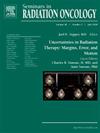The Evolving Management of Radiorecurrent Prostate Cancer
IF 3.2
3区 医学
Q3 ONCOLOGY
引用次数: 0
Abstract
The detection of local radiorecurrence (LRR) of prostate cancer in the prostate or prostate bed after radiation therapy is increasingly common with the advent of advanced imaging modalities such as the PSMA PET/CT. Our aim is to review the literature and define the optimal workup for identifying LRR and discuss the key principals in management, with a focus on salvage re-irradiation. We performed a narrative review of the literature and ongoing studies centered on LRR workup and treatment. Workup for biochemical recurrence postradiation therapy includes PSMA PET/CT, multiparametric MRI, and systematic and targeted biopsy to confirm and define the extent of LRR. Historically, treatment options have included observation, palliative androgen deprivation therapy (ADT), or salvage local therapy to eradicate the LRR. Salvage local re-irradiation can be delivered using stereotactic body radiotherapy (SBRT), high dose rate (HDR) brachytherapy, or low dose rate (LDR) brachytherapy. Commonly used treatment regimens and practical considerations for the different salvage re-irradiation modalities based on the available literature are discussed. Salvage re-irradiation is a safe and effective treatment approach that offers a second chance to “cure” prostate cancer, while also delaying the need for palliative hormonal therapy. Salvage re-irradiation should be carefully considered in patients with LRR after weighing potential benefits against risks. Further data are needed to identify the optimal volume, dose and fractionation regimens.
放射复发性前列腺癌的发展管理
随着PSMA PET/CT等先进成像技术的出现,前列腺癌放射治疗后前列腺或前列腺床局部放射复发(LRR)的检测越来越普遍。我们的目的是回顾文献并定义识别LRR的最佳工作,并讨论管理中的关键原则,重点是回收再辐照。我们对以LRR随访和治疗为中心的文献和正在进行的研究进行了叙述性回顾。放射治疗后生化复发的检查包括PSMA PET/CT、多参数MRI以及系统和靶向活检,以确认和确定LRR的程度。从历史上看,治疗方案包括观察,姑息性雄激素剥夺疗法(ADT),或挽救局部治疗以根除LRR。抢救性局部再照射可采用立体定向全身放疗(SBRT)、高剂量率(HDR)近距离放疗或低剂量率(LDR)近距离放疗。根据现有文献,讨论了常用的治疗方案和不同打捞再照射方式的实际考虑。补救性再照射是一种安全有效的治疗方法,为“治愈”前列腺癌提供了第二次机会,同时也推迟了姑息性激素治疗的需要。对于LRR患者,在权衡潜在的获益与风险后,应仔细考虑补救性再照射。需要进一步的数据来确定最佳的体积、剂量和分离方案。
本文章由计算机程序翻译,如有差异,请以英文原文为准。
求助全文
约1分钟内获得全文
求助全文
来源期刊
CiteScore
5.80
自引率
0.00%
发文量
48
审稿时长
>12 weeks
期刊介绍:
Each issue of Seminars in Radiation Oncology is compiled by a guest editor to address a specific topic in the specialty, presenting definitive information on areas of rapid change and development. A significant number of articles report new scientific information. Topics covered include tumor biology, diagnosis, medical and surgical management of the patient, and new technologies.

 求助内容:
求助内容: 应助结果提醒方式:
应助结果提醒方式:


